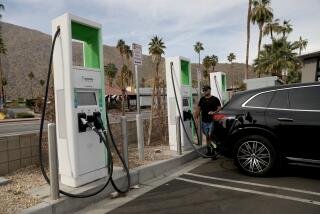GM’s EV1 Gears Up Amid Charge of the Ad Brigade
- Share via
TROY, Mich. — With plenty of input from Hollywood types, Saturn Corp. on Monday launched a $10-million advertising campaign for General Motors’ EV1 electric car, which will be introduced in Southern California and Arizona on Dec. 5.
The battery-powered vehicle--the first electric car built from scratch to be mass-marketed in 80 years--is being touted in teaser ads unveiled Monday on 24 billboards in Los Angeles and three in San Diego.
The ads display a lightning bolt overlaid with the message, “You can’t hear it coming, but it is.” The day the EV1 goes on sale, new billboard ads will go up that picture the sleek two-seater and say, “The electric car is here.”
The ad campaign, developed by Saturn’s longtime agency Hal Riney & Partners of San Francisco, will also feature television, movie theater, newspaper and magazine spots, as well as a World Wide Web page on the Internet.
The campaign’s centerpiece is a 90-second, special-effects TV ad that highlights the EV1’s electric heritage by conjuring up animated household appliances that are awed by the battery-powered car.
The commercial was directed by Joe Johnston, the director of the “Jumanji” and “Rocketeer” movies, and it uses the computer animation wizardry of Industrial Light & Magic, the special-effects firm owned by “Star Wars” creator George Lucas.
The commercial begins with a thunderstorm that briefly knocks out the power in a suburban Los Angeles house. When the electricity comes back on, the household appliances suddenly come to life.
The appliances unplug themselves, march out the door and stand along the curb as the EV1 slowly approaches. The admiring machines surround the car as the voice of actress Linda Hunt announces its arrival.
“It’s intended as a celebration of the arrival of the electric vehicle,” said Joseph Kennedy, vice president of marketing for Saturn.
Other EV1 ads provide a more contemplative approach. The idea is to impart to consumers the idea that the zero-emissions EV1 is dramatically different from today’s gasoline-powered vehicles.
For instance, the first two-page newspaper ads that will appear in the Los Angeles Times and the California edition of the Wall Street Journal depict reeds blowing in the wind as the vehicle drives by. The ad says: “There is no noise. No pistons. No valves or exhaust. Just the whir of an AC motor. And the wind. And your thoughts, of course. As you drive the electric car.”
The EV1, which retails for about $34,000, the price of a typical luxury sports coupe, will be offered at 25 Saturn dealerships in California and Arizona. It won’t be sold outright, but rather leased for three years for roughly $480 a month after various federal, state and local tax incentives.
GM would not provide production or sales projections. But industry sources said the company is unlikely to produce or sell more than 2,000 in the first year, and perhaps only half that.
GM hopes to use the EV1 to build a market for alternative-fuel vehicles, so executives say sales volume is initially less important than providing early buyers with a positive driving and ownership experience.
More than 1,000 consumers have sought information on the new vehicle, Saturn executives said, and about a quarter of those are considered to be serious about it.
The first sales will be accompanied by plenty of Hollywood hoopla. Numerous entertainment celebrities are expected to be among the first buyers, including “Tonight Show” host and car buff Jay Leno.
EV1 owners are expected to be 35 to 54 years old, well-educated, with annual family income of more than $125,000, and with a high interest in technology and the environment.
The initial 90-second TV ads will be shown in prime time. They will also be shown on cable news, arts and science shows. Thirty- and 60-second spots will begin airing Dec. 6.
The magazine ads will run in an eclectic selection of 17 publications.
Saturn is also preparing a site on the Web. The address is https://www.gmev.com






